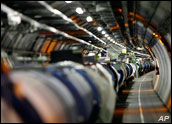
Nothing is official yet, but it looks like the new particle detected in July in experiments conducted at the CERN Large Hadron Collider may indeed be the Higgs boson or so-called “God particle,” scientists announced Thursday at a physics conference in Geneva.
The scientists have analyzed two-and-a-half times more data on their discovery than what was available last summer. However, they aren’t sure yet whether this is the Higgs boson predicted by the Standard Model of particle physics, or the lightest of several bosons predicted in some theories that go beyond the Standard Model.
One of the things scientists have to do to verify which boson was discovered is to precisely measure the rate at which the boson decays into other particles, and then compare the results to the predictions.
Is It the Real Higgs?
Back in July, some scientists asked whether CERN had indeed discovered the Higgs boson or an imposter.
“There is no indication that this is not a Standard Model Higgs at present,” Dan Green, a senior scientist emeritus at Fermilab’s CMS Center, told TechNewsWorld. “More data has shrunk the possibilities of a non-Standard Model Higgs.”
A large decay rate into two photons was seen earlier, but that had large statistical errors, and the data “has now settled to a value closer to the Standard Model,” he said.
Next Steps
The issue scientists are facing now is finding out what protects the Higgs boson’s low mass from radiative corrections. “Something limits the mass to about 125 GeV and we don’t know what that is — yet,” Green said.
There’s a level of certainty that the particle discovered is indeed the Higgs boson, but “in science, you cannot say with certainty what you have seen,” he said. The scientists want what they refer to as “5-sigma” confidence “for all the possible decay modes of the Higgs, and that will take several years of the LHC running at increased luminosity and higher energy.”
The scientists are “being super-cautious,” William Newman, professor of earth and space sciences at theUniversity of California at Los Angeles, told TechNewsWorld. “The original discovery was a 5-sigma discovery and that’s a super-gold standard; it’s almost the holy grail.”
Validation of the Standard Model at this level “excludes a large variety of competing models that people have been putting forth, and that dramatically constrains how the universe can behave,” he said.
Why Search for Decay?
The Higgs boson has no spin, no electric charge and no color charge, and is its own antiparticle. It doesn’t exist except as a theoretical construct, and here’s why: It accompanies the Higgs Field, a possible invisible field of energy that exists throughout the universe.
In the Standard Model, the Higgs field consists of four components — two charged component fields and two neutral ones. Both the charged components and one of the neutral fields are Goldstone bosons. The quantum of the last, neutral component is theoretically realized as the Higgs boson.
Quantum mechanics theory holds that particles will decay into a set of lighter particles if it’s possible for them to do so. The likelihood of this occurring depends on various factors, including the difference in mass between the original particle, and the ones it decays into and the strength of the interactions. The Standard Model fixes most of these factors except for the mass of the Higgs boson itself.





















































